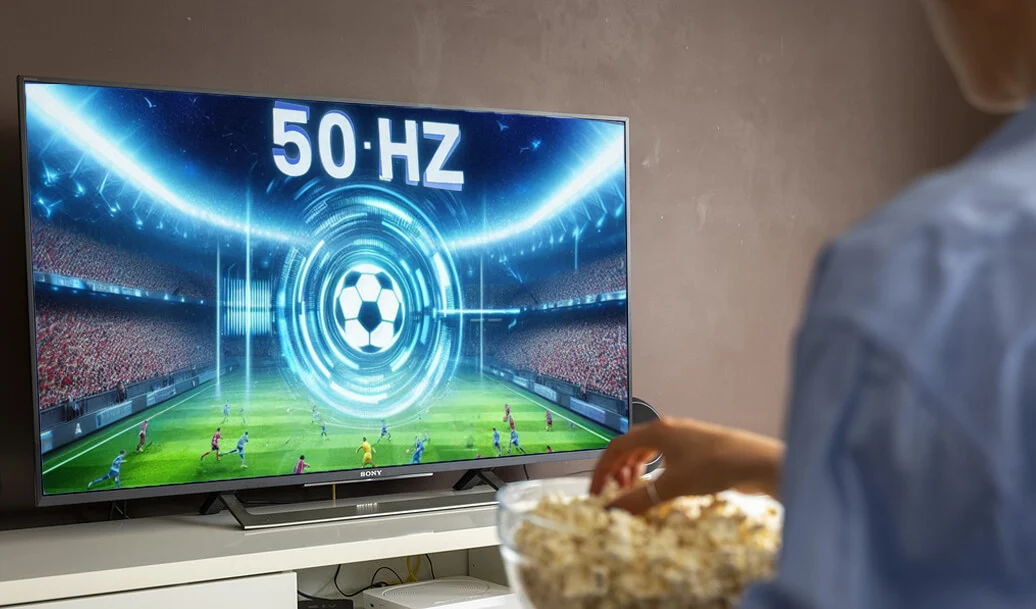
In this article, I’ll walk you through how to set up and configure such devices to achieve the perfect combination of resolution and refresh rate for your content. Whether you’re streaming live sports, catching up on a movie, or binge-watching your favorite series, this guide has you covered. I’ve tested this solution on both a 2014 Samsung Smart TV and a 2019 Sony TV, and it works like a charm on both.
Why there is Stuttering and Juddering on Android TV Streaming
Most TVs default to a refresh rate of 60Hz, which works fine for a lot of content but isn’t ideal for everything. Here’s why:
- Sports and European TV Broadcasts: Many sports streams and TV broadcasts in Europe use a 50Hz refresh rate. Watching this content at 60Hz can result in a “juddery” playback experience.
- Movies: Films are typically shot at 24fps, so matching your TV's refresh rate to 24Hz or a multiple of it (like 48Hz or 120Hz) can improve motion clarity.
- Games: For gaming, you’ll often want the highest refresh rate possible (e.g., 60Hz or higher).
The problem? Many smart TVs don't let you manually adjust the refresh rate or resolution for built-in apps, leaving you stuck with suboptimal settings.
How an External HDMI Device Can Save the Day
Devices like the Mi Box S, Google Chromecast with Google TV, and similar Android TV players offer the ability to fine-tune the resolution and refresh rate. By connecting these devices via HDMI, you essentially bypass your TV’s limitations.
Benefits of Using an External Android TV Device:
- Resolution and Refresh Rate Control: Easily switch between options like 1080p@50Hz, 4K@24Hz, or whatever suits your content.
- Smooth Playback: Avoid juddering or stuttering in sports and movie content.
- Compatibility: These devices work on virtually any TV with an HDMI port, even older models.
Setting Up Your Android TV Device
Here’s how to get started with an external device like the Mi Box S:
- Plug your Android TV device (e.g., Mi Box S) into one of your TV’s HDMI ports.
- Use the included power adapter to connect the device to a power outlet.
- Switch your TV’s input to the corresponding HDMI port.
- Follow the on-screen instructions to set up Wi-Fi and log in to your Google account.
- Install your favorite streaming apps like YouTube, Netflix, or your sports app of choice.
- Go to Settings > Device Preferences > Display.
- Under Resolution, choose 1080p or your desired resolution.
- Under Refresh Rate, select 50Hz for sports or European TV content, or stick with 60Hz for general content.
- If available, enable Match Content Frame Rate, which automatically adjusts the refresh rate based on the video you're playing.
- Open a streaming app and play content. Watch for any signs of judder or stuttering.
- If playback isn’t smooth, try switching refresh rates again.
Personal Testing: Real-World Results
I’ve personally tested this solution on two different TVs:
2014 Samsung Smart TV: This older model doesn’t support 50Hz for its built-in apps. By connecting the Mi Box S, I was able to switch to 1080p@50Hz and enjoy smooth sports streaming without upgrading my TV.
2019 Sony TV (Android 9): While this TV supports some advanced features, its built-in apps don’t allow refresh rate changes. Again, connecting the Mi Box S let me select 50Hz, solving the problem instantly.
In both cases, the difference was night and day. Live sports became fluid, and movies had that cinematic feel with no distracting motion issues.
What Makes Android TV Devices Great for Smooth Streaming?
Android TV devices like the Mi Box S, Google Chromecast with Google TV, and others are built with flexibility in mind. Here are some options you might consider:
- Mi Box S: Affordable and reliable, with solid performance for 1080p and 4K streaming.
- Google Chromecast with Google TV: A sleek, powerful option with excellent integration for apps and voice controls.
- NVIDIA Shield TV: Perfect for gamers and advanced users who want the best performance and features.
- Amazon Fire TV Stick 4K Max: While it’s not Android TV, this device also allows resolution and refresh rate changes.
Additional Tips for Smooth Streaming
- Use High-Quality HDMI Cables: Ensure your HDMI cables support the resolution and refresh rate you’re using (e.g., HDMI 2.0 for 4K@60Hz).
- Enable HDR: If your TV and Android TV device support HDR, turn it on for better contrast and color.
- Update Firmware: Keep your Android TV device and TV firmware updated for the latest features and bug fixes.
Final Thoughts on Fixing Stuttering and Juddering
If you’re struggling to watch smooth sports or movie content on your smart TV, an external Android TV device can be a game-changer. Whether you’re using a Mi Box S, Google Chromecast with Google TV, or another device, the ability to fine-tune your resolution and refresh rate ensures you’ll always have the best possible viewing experience.
This simple yet effective solution works on a wide range of TVs, from older models like my 2014 Samsung to newer ones like my 2019 Sony. So, don’t let your TV’s built-in limitations hold you back—grab an external device and enjoy smooth, stutter-free streaming today.
Let me know in the comments if you’ve tried this or if you have any other tips for improving your streaming experience!
